Weiying Xie
High-Energy Concentration for Federated Learning in Frequency Domain
Sep 16, 2025Abstract:Federated Learning (FL) presents significant potential for collaborative optimization without data sharing. Since synthetic data is sent to the server, leveraging the popular concept of dataset distillation, this FL framework protects real data privacy while alleviating data heterogeneity. However, such methods are still challenged by the redundant information and noise in entire spatial-domain designs, which inevitably increases the communication burden. In this paper, we propose a novel Frequency-Domain aware FL method with high-energy concentration (FedFD) to address this problem. Our FedFD is inspired by the discovery that the discrete cosine transform predominantly distributes energy to specific regions, referred to as high-energy concentration. The principle behind FedFD is that low-energy like high-frequency components usually contain redundant information and noise, thus filtering them helps reduce communication costs and optimize performance. Our FedFD is mathematically formulated to preserve the low-frequency components using a binary mask, facilitating an optimal solution through frequency-domain distribution alignment. In particular, real data-driven synthetic classification is imposed into the loss to enhance the quality of the low-frequency components. On five image and speech datasets, FedFD achieves superior performance than state-of-the-art methods while reducing communication costs. For example, on the CIFAR-10 dataset with Dirichlet coefficient $\alpha = 0.01$, FedFD achieves a minimum reduction of 37.78\% in the communication cost, while attaining a 10.88\% performance gain.
Hyperspectral Mamba for Hyperspectral Object Tracking
Sep 10, 2025Abstract:Hyperspectral object tracking holds great promise due to the rich spectral information and fine-grained material distinctions in hyperspectral images, which are beneficial in challenging scenarios. While existing hyperspectral trackers have made progress by either transforming hyperspectral data into false-color images or incorporating modality fusion strategies, they often fail to capture the intrinsic spectral information, temporal dependencies, and cross-depth interactions. To address these limitations, a new hyperspectral object tracking network equipped with Mamba (HyMamba), is proposed. It unifies spectral, cross-depth, and temporal modeling through state space modules (SSMs). The core of HyMamba lies in the Spectral State Integration (SSI) module, which enables progressive refinement and propagation of spectral features with cross-depth and temporal spectral information. Embedded within each SSI, the Hyperspectral Mamba (HSM) module is introduced to learn spatial and spectral information synchronously via three directional scanning SSMs. Based on SSI and HSM, HyMamba constructs joint features from false-color and hyperspectral inputs, and enhances them through interaction with original spectral features extracted from raw hyperspectral images. Extensive experiments conducted on seven benchmark datasets demonstrate that HyMamba achieves state-of-the-art performance. For instance, it achieves 73.0\% of the AUC score and 96.3\% of the DP@20 score on the HOTC2020 dataset. The code will be released at https://github.com/lgao001/HyMamba.
Hyperspectral Adapter for Object Tracking based on Hyperspectral Video
Mar 28, 2025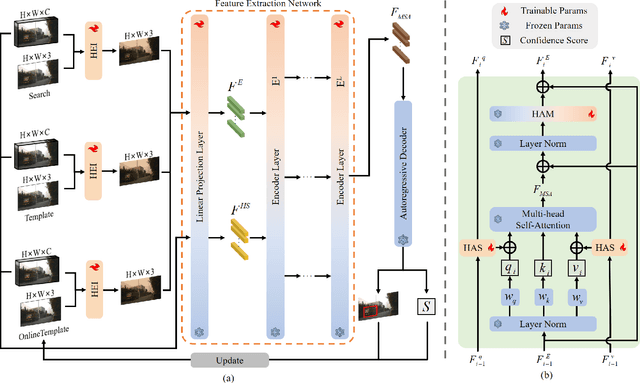
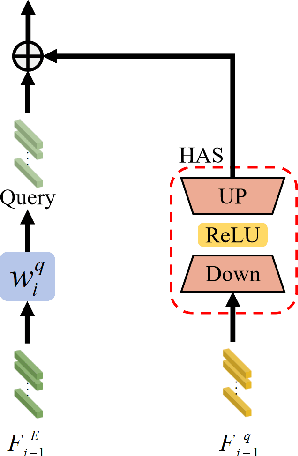
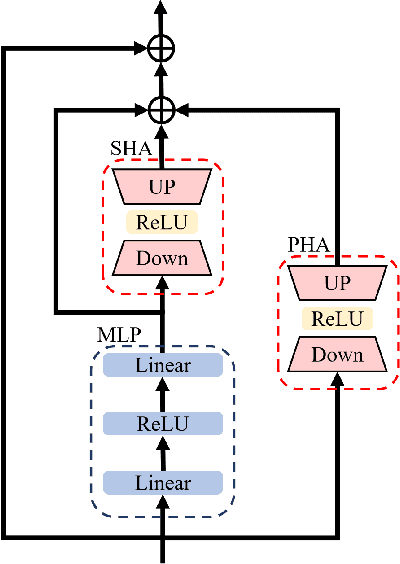
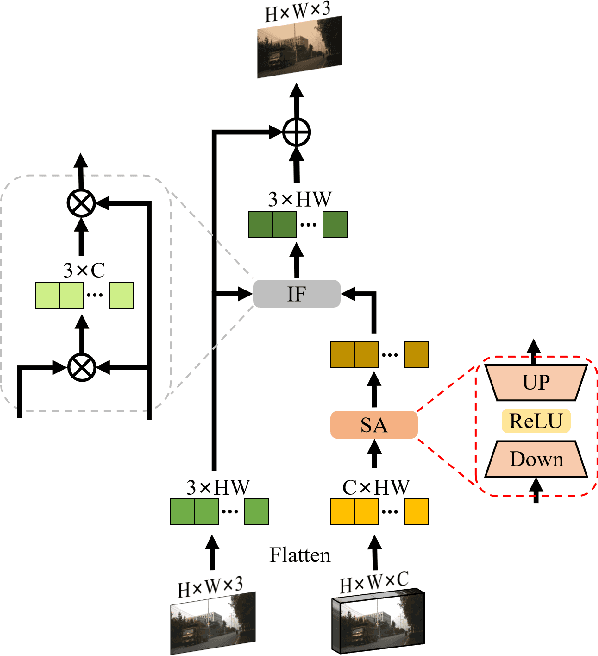
Abstract:Object tracking based on hyperspectral video attracts increasing attention to the rich material and motion information in the hyperspectral videos. The prevailing hyperspectral methods adapt pretrained RGB-based object tracking networks for hyperspectral tasks by fine-tuning the entire network on hyperspectral datasets, which achieves impressive results in challenging scenarios. However, the performance of hyperspectral trackers is limited by the loss of spectral information during the transformation, and fine-tuning the entire pretrained network is inefficient for practical applications. To address the issues, a new hyperspectral object tracking method, hyperspectral adapter for tracking (HyA-T), is proposed in this work. The hyperspectral adapter for the self-attention (HAS) and the hyperspectral adapter for the multilayer perceptron (HAM) are proposed to generate the adaption information and to transfer the multi-head self-attention (MSA) module and the multilayer perceptron (MLP) in pretrained network for the hyperspectral object tracking task by augmenting the adaption information into the calculation of the MSA and MLP. Additionally, the hyperspectral enhancement of input (HEI) is proposed to augment the original spectral information into the input of the tracking network. The proposed methods extract spectral information directly from the hyperspectral images, which prevent the loss of the spectral information. Moreover, only the parameters in the proposed methods are fine-tuned, which is more efficient than the existing methods. Extensive experiments were conducted on four datasets with various spectral bands, verifing the effectiveness of the proposed methods. The HyA-T achieves state-of-the-art performance on all the datasets.
M$^3$amba: CLIP-driven Mamba Model for Multi-modal Remote Sensing Classification
Mar 09, 2025Abstract:Multi-modal fusion holds great promise for integrating information from different modalities. However, due to a lack of consideration for modal consistency, existing multi-modal fusion methods in the field of remote sensing still face challenges of incomplete semantic information and low computational efficiency in their fusion designs. Inspired by the observation that the visual language pre-training model CLIP can effectively extract strong semantic information from visual features, we propose M$^3$amba, a novel end-to-end CLIP-driven Mamba model for multi-modal fusion to address these challenges. Specifically, we introduce CLIP-driven modality-specific adapters in the fusion architecture to avoid the bias of understanding specific domains caused by direct inference, making the original CLIP encoder modality-specific perception. This unified framework enables minimal training to achieve a comprehensive semantic understanding of different modalities, thereby guiding cross-modal feature fusion. To further enhance the consistent association between modality mappings, a multi-modal Mamba fusion architecture with linear complexity and a cross-attention module Cross-SS2D are designed, which fully considers effective and efficient information interaction to achieve complete fusion. Extensive experiments have shown that M$^3$amba has an average performance improvement of at least 5.98\% compared with the state-of-the-art methods in multi-modal hyperspectral image classification tasks in the remote sensing field, while also demonstrating excellent training efficiency, achieving a double improvement in accuracy and efficiency. The code is released at https://github.com/kaka-Cao/M3amba.
Towards Efficient Model-Heterogeneity Federated Learning for Large Models
Nov 25, 2024Abstract:As demand grows for complex tasks and high-performance applications in edge computing, the deployment of large models in federated learning has become increasingly urgent, given their superior representational power and generalization capabilities. However, the resource constraints and heterogeneity among clients present significant challenges to this deployment. To tackle these challenges, we introduce HeteroTune, an innovative fine-tuning framework tailored for model-heterogeneity federated learning (MHFL). In particular, we propose a novel parameter-efficient fine-tuning (PEFT) structure, called FedAdapter, which employs a multi-branch cross-model aggregator to enable efficient knowledge aggregation across diverse models. Benefiting from the lightweight FedAdapter, our approach significantly reduces both the computational and communication overhead. Finally, our approach is simple yet effective, making it applicable to a wide range of large model fine-tuning tasks. Extensive experiments on computer vision (CV) and natural language processing (NLP) tasks demonstrate that our method achieves state-of-the-art results, seamlessly integrating efficiency and performance.
Towards Accurate and Efficient Sub-8-Bit Integer Training
Nov 17, 2024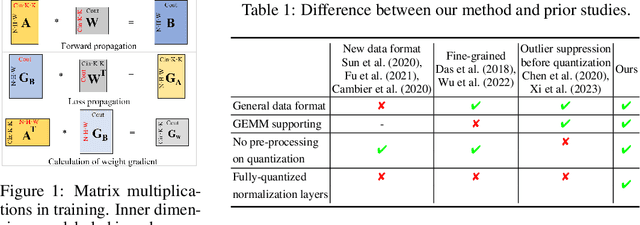
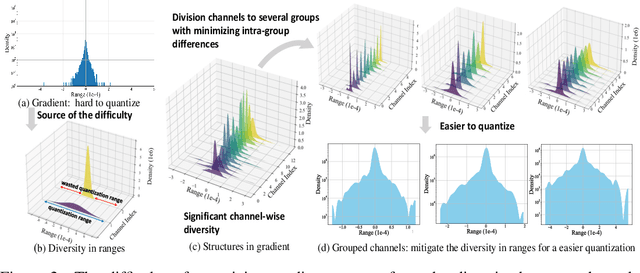

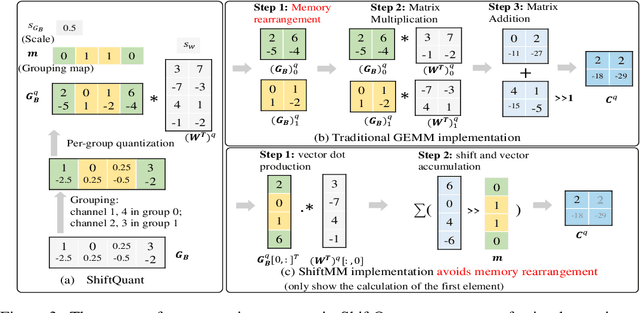
Abstract:Neural network training is a memory- and compute-intensive task. Quantization, which enables low-bitwidth formats in training, can significantly mitigate the workload. To reduce quantization error, recent methods have developed new data formats and additional pre-processing operations on quantizers. However, it remains quite challenging to achieve high accuracy and efficiency simultaneously. In this paper, we explore sub-8-bit integer training from its essence of gradient descent optimization. Our integer training framework includes two components: ShiftQuant to realize accurate gradient estimation, and L1 normalization to smoothen the loss landscape. ShiftQuant attains performance that approaches the theoretical upper bound of group quantization. Furthermore, it liberates group quantization from inefficient memory rearrangement. The L1 normalization facilitates the implementation of fully quantized normalization layers with impressive convergence accuracy. Our method frees sub-8-bit integer training from pre-processing and supports general devices. This framework achieves negligible accuracy loss across various neural networks and tasks ($0.92\%$ on 4-bit ResNets, $0.61\%$ on 6-bit Transformers). The prototypical implementation of ShiftQuant achieves more than $1.85\times/15.3\%$ performance improvement on CPU/GPU compared to its FP16 counterparts, and $33.9\%$ resource consumption reduction on FPGA than the FP16 counterparts. The proposed fully-quantized L1 normalization layers achieve more than $35.54\%$ improvement in throughout on CPU compared to traditional L2 normalization layers. Moreover, theoretical analysis verifies the advancement of our method.
SeaDATE: Remedy Dual-Attention Transformer with Semantic Alignment via Contrast Learning for Multimodal Object Detection
Oct 15, 2024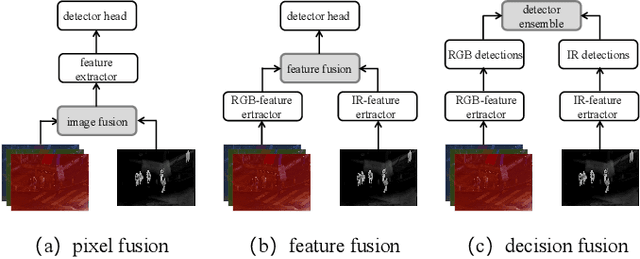
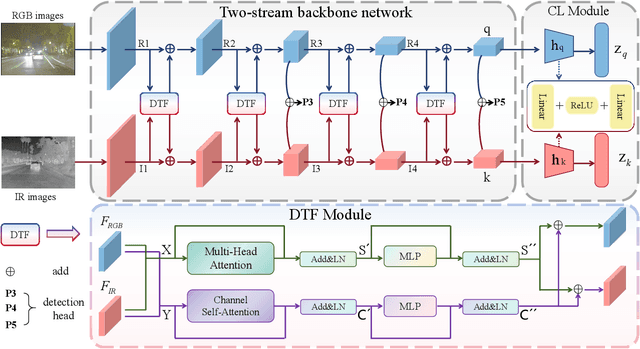
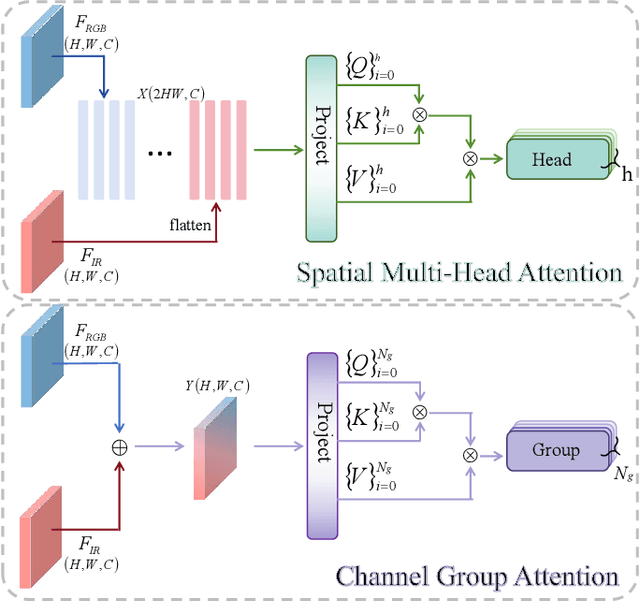
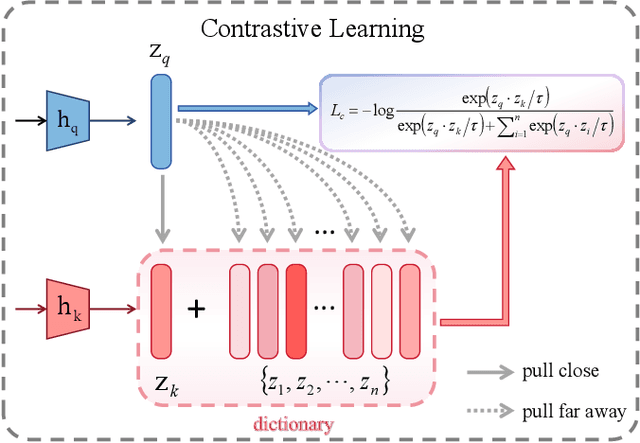
Abstract:Multimodal object detection leverages diverse modal information to enhance the accuracy and robustness of detectors. By learning long-term dependencies, Transformer can effectively integrate multimodal features in the feature extraction stage, which greatly improves the performance of multimodal object detection. However, current methods merely stack Transformer-guided fusion techniques without exploring their capability to extract features at various depth layers of network, thus limiting the improvements in detection performance. In this paper, we introduce an accurate and efficient object detection method named SeaDATE. Initially, we propose a novel dual attention Feature Fusion (DTF) module that, under Transformer's guidance, integrates local and global information through a dual attention mechanism, strengthening the fusion of modal features from orthogonal perspectives using spatial and channel tokens. Meanwhile, our theoretical analysis and empirical validation demonstrate that the Transformer-guided fusion method, treating images as sequences of pixels for fusion, performs better on shallow features' detail information compared to deep semantic information. To address this, we designed a contrastive learning (CL) module aimed at learning features of multimodal samples, remedying the shortcomings of Transformer-guided fusion in extracting deep semantic features, and effectively utilizing cross-modal information. Extensive experiments and ablation studies on the FLIR, LLVIP, and M3FD datasets have proven our method to be effective, achieving state-of-the-art detection performance.
FusionSAM: Latent Space driven Segment Anything Model for Multimodal Fusion and Segmentation
Aug 26, 2024
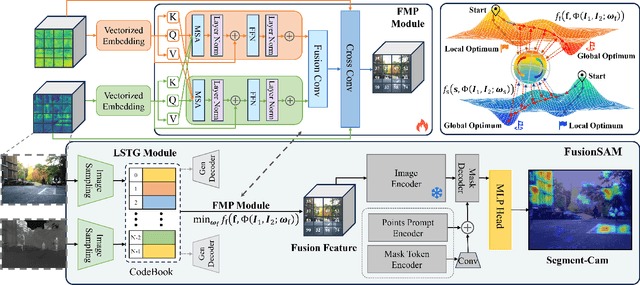
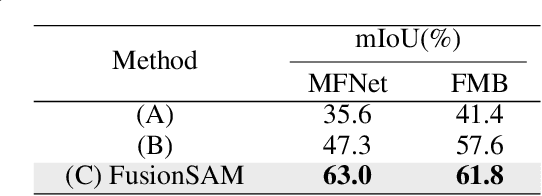

Abstract:Multimodal image fusion and segmentation enhance scene understanding in autonomous driving by integrating data from various sensors. However, current models struggle to efficiently segment densely packed elements in such scenes, due to the absence of comprehensive fusion features that can guide mid-process fine-tuning and focus attention on relevant areas. The Segment Anything Model (SAM) has emerged as a transformative segmentation method. It provides more effective prompts through its flexible prompt encoder, compared to transformers lacking fine-tuned control. Nevertheless, SAM has not been extensively studied in the domain of multimodal fusion for natural images. In this paper, we introduce SAM into multimodal image segmentation for the first time, proposing a novel framework that combines Latent Space Token Generation (LSTG) and Fusion Mask Prompting (FMP) modules to enhance SAM's multimodal fusion and segmentation capabilities. Specifically, we first obtain latent space features of the two modalities through vector quantization and embed them into a cross-attention-based inter-domain fusion module to establish long-range dependencies between modalities. Then, we use these comprehensive fusion features as prompts to guide precise pixel-level segmentation. Extensive experiments on several public datasets demonstrate that the proposed method significantly outperforms SAM and SAM2 in multimodal autonomous driving scenarios, achieving at least 3.9$\%$ higher segmentation mIoU than the state-of-the-art approaches.
Reducing Spurious Correlation for Federated Domain Generalization
Jul 27, 2024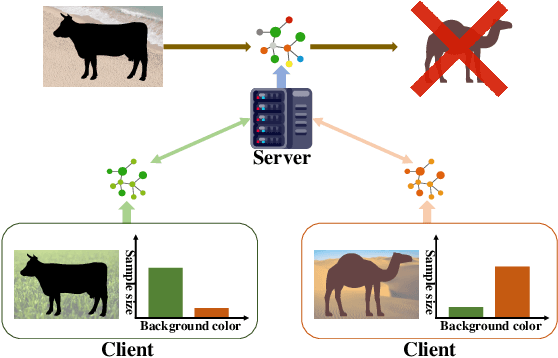
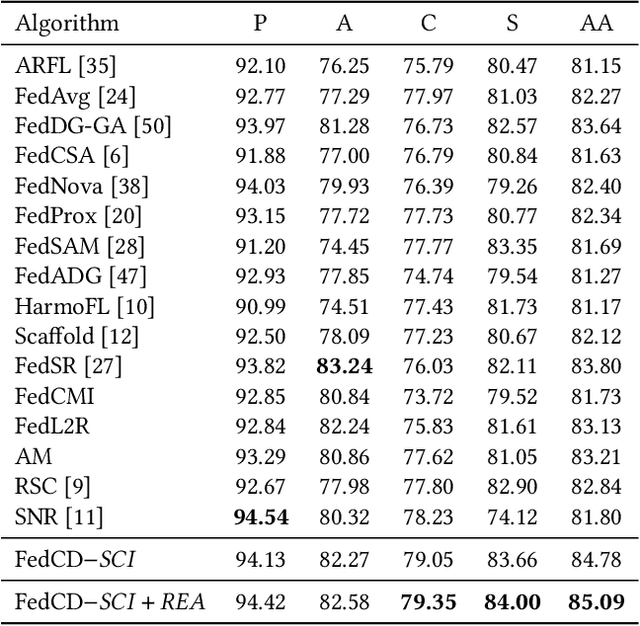
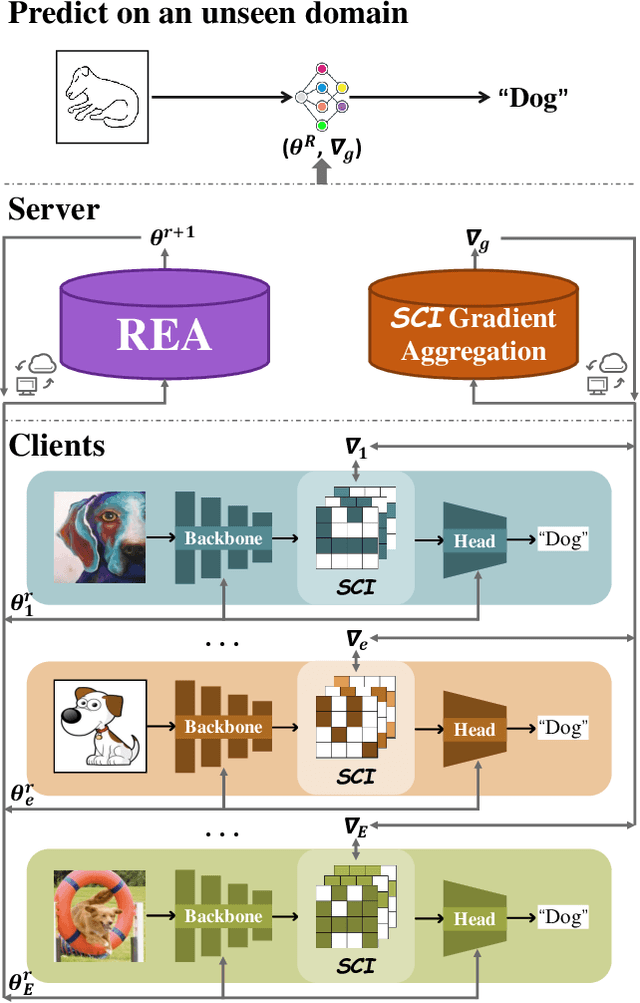
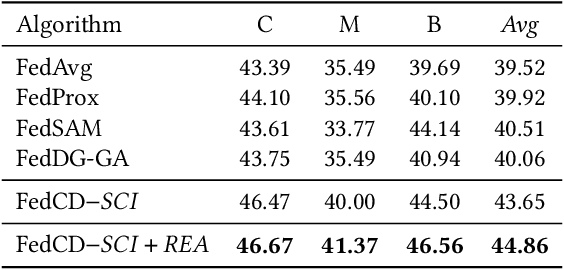
Abstract:The rapid development of multimedia has provided a large amount of data with different distributions for visual tasks, forming different domains. Federated Learning (FL) can efficiently use this diverse data distributed on different client media in a decentralized manner through model sharing. However, in open-world scenarios, there is a challenge: global models may struggle to predict well on entirely new domain data captured by certain media, which were not encountered during training. Existing methods still rely on strong statistical correlations between samples and labels to address this issue, which can be misleading, as some features may establish spurious short-cut correlations with the predictions. To comprehensively address this challenge, we introduce FedCD (Cross-Domain Invariant Federated Learning), an overall optimization framework at both the local and global levels. We introduce the Spurious Correlation Intervener (SCI), which employs invariance theory to locally generate interventers for features in a self-supervised manner to reduce the model's susceptibility to spurious correlated features. Our approach requires no sharing of data or features, only the gradients related to the model. Additionally, we develop the simple yet effective Risk Extrapolation Aggregation strategy (REA), determining aggregation coefficients through mathematical optimization to facilitate global causal invariant predictions. Extensive experiments and ablation studies highlight the effectiveness of our approach. In both classification and object detection generalization tasks, our method outperforms the baselines by an average of at least 1.45% in Acc, 4.8% and 1.27% in mAP50.
FoRA: Low-Rank Adaptation Model beyond Multimodal Siamese Network
Jul 23, 2024Abstract:Multimodal object detection offers a promising prospect to facilitate robust detection in various visual conditions. However, existing two-stream backbone networks are challenged by complex fusion and substantial parameter increments. This is primarily due to large data distribution biases of multimodal homogeneous information. In this paper, we propose a novel multimodal object detector, named Low-rank Modal Adaptors (LMA) with a shared backbone. The shared parameters enhance the consistency of homogeneous information, while lightweight modal adaptors focus on modality unique features. Furthermore, we design an adaptive rank allocation strategy to adapt to the varying heterogeneity at different feature levels. When applied to two multimodal object detection datasets, experiments validate the effectiveness of our method. Notably, on DroneVehicle, LMA attains a 10.4% accuracy improvement over the state-of-the-art method with a 149M-parameters reduction. The code is available at https://github.com/zyszxhy/FoRA. Our work was submitted to ACM MM in April 2024, but was rejected. We will continue to refine our work and paper writing next, mainly including proof of theory and multi-task applications of FoRA.
 Add to Chrome
Add to Chrome Add to Firefox
Add to Firefox Add to Edge
Add to Edge